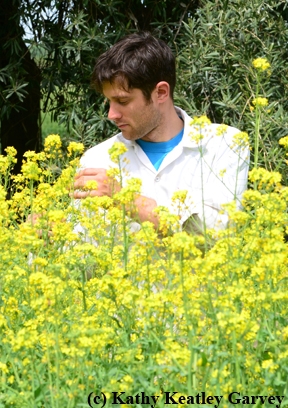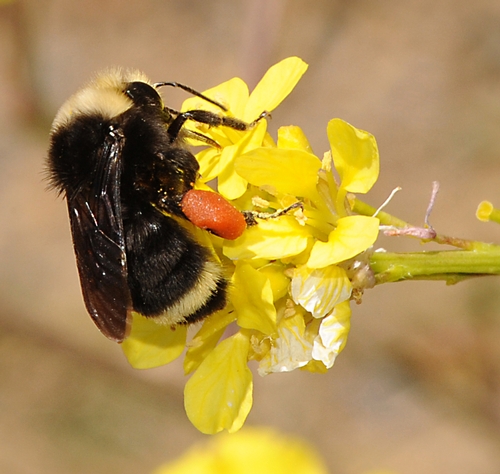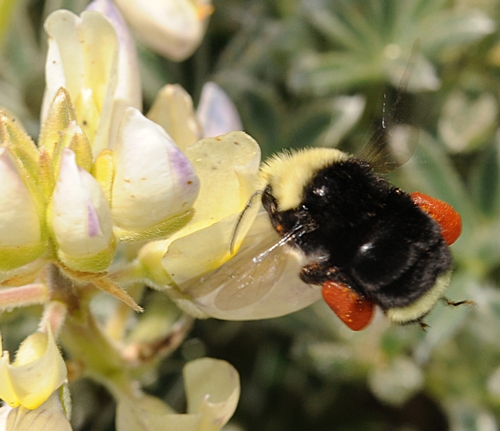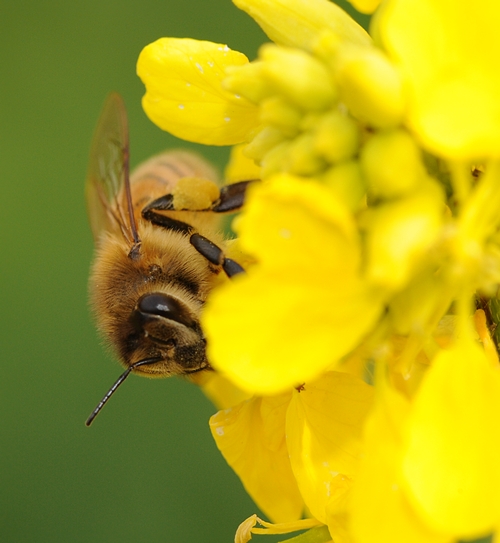- Author: Kathy Keatley Garvey
Good news for the honey bees!
And none too soon.
U.S. Department of Agriculture (USDA) Secretary Tom Vilsack announced today (Oct. 29) in a press release that "more than $4 million in technical and financial assistance will be provided to help farmers and ranchers in the Midwest improve the health of honey bees, which play an important role in crop production."
“The future of America's food supply depends on honey bees, and this effort is one way USDA is helping improve the health of honey bee populations,” Vilsack said in the USDA release. “Significant progress has been made in understanding the factors that are associated with Colony Collapse Disorder and the overall health of honey bees, and this funding will allow us to work with farmers and ranchers to apply that knowledge over a broader area.”
The declining honey bee population is besieged with health issues, exacerbated by pests, parasites, pesticides, diseases, stress and malnutrition Nationally, however, honey bees pollinate an estimated $15 billion worth of crops, including more than 130 fruits and vegetables. If you enjoy such produce as almonds, apples, cherries, cucumbers, and peaches, thank a bee for its pollination services.
USDA's Natural Resources Conservation Service (NRCS) is focusing the effort on five Midwestern states: Michigan, Minnesota, North Dakota, South Dakota and Wisconsin.
Why the Midwest? "From June to September, the Midwest is home to more than 65 percent of the commercially managed honey bees in the country. It is a critical time when bees require abundant and diverse forage across broad landscapes to build up hive strength for the winter."
The announcement renews and expands what USDA calls "a successful $3 million pilot investment that was announced earlier this year and continues to have high levels of interest." It's all part of the June 2014 Presidential Memorandum – Creating a Federal Strategy to Promote the Health of Honey Bees and Other Pollinators, which directs USDA to expand the acreage and forage value in its conservation programs.
Funding will be provided to producers through the Environmental Quality Incentives Program (EQIP). Applications are due Friday, Nov. 21.
This means that the farmers and ranchers will receive support and guidance to implement conservation practices that will provide safe and diverse food sources for honey bees. This will include appropriate cover crops or rangeland and pasture management. In addition to providing good forage and habitat for honey bees and other pollinators, the actions taken are expected to reduce erosion, increase soil health and inhibit invasive species.
California also will benefit. "This year, several NRCS state offices are setting aside additional funds for similar efforts, including California – where more than half of all managed honey bees in the U.S. help pollinate almond groves and other agricultural lands – as well as Ohio and Florida," according to the release.
A nice push for the pollinators!

- Author: Kathy Keatley Garvey

You wouldn't know it if you were to visit the two rapini patches in front of the Harry H. Laidlaw Jr. Honey Bee Research Facility on Bee Biology Road, University of California, Davis.
“The bees love the rapini,” said Laidlaw manager and staff research associate Billy Synk, who planted the seeds given him by Project Apis m.
Project apis m., a moniker derived from Apis mellifera, the scientific name of the European honey bee, funds and directs research to enhance the health and vitality of honey bee colonies while improving crop production. It's based in Paso Robles, Calif. Take a look at the organization's website: "We've infused over $2.5 million into bee research since our inception in 2006 to provide growers with healthier bees resulting in better pollination and increased crop yields. We have personal relationships with the nation's commercial beekeepers and with the top bee scientists in the country."
"We fund research studies, purchase equipment for bee labs at our universities, support graduate students and provide scholarships to young bee scientists to encourage their pursuit of science-based solutions to honey bee challenges."
Its eight-member board includes beekeepers and industry leaders. Extension apiculturist Eric Mussen of UC Davis is a longtime scientific advisor.
And rapini? It's a green cruciferous vegetable from the mustard family. The leaves, buds and stems are edible and often served in restaurants throughout the world. If you were in Italy, you'd eat the cimi di rapa or rapini. In Naples, it's known as friarielli and sometimes broccoli di rapa, according to Wikipedia. If you were in Rome, broccoletti. And in Portugal and Spain, grelos.
The bees know it as simply food for their colonies. Good stuff. (In addition to rapini, PAm encourages folks to plant lovers, vetch, allysum, and native wildflowers as bee pasture.)
One thing's for certain: If you plan to participate in the UC Agriculture and Natural Resources' pollinator count for a three-minute period on Thursday, May 8 your eyes will tire from counting all the bees in the rapini!
Like to participate? See the UC ANR's website, Day of Science and Service. You can also photograph pollinators and post the images on the website for all to see and enjoy.




- Author: Kathy Keatley Garvey
St. Patrick's Day is the "wearing of the green," but it's also the "wearing of the yellow."
Wild mustard, that is.
If you drive through the hills of Napa, around St. Patrick's Day, or from January through March, you'll see bee hives nestled in the green landscape with a flourish of mustard (Brassica spp.).
It's a child's delight, a photographer's dream, and a painter's inspiration. But mustard is also a good cover crop and bee food.
Indeed, honey bees crave mustard just like folks on "Irish Day" crave corned bee and cabbage (with that yellow condiment made from mustard seeds).


- Author: Kathy Keatley Garvey
The yellow-faced bumble bee (Bombus vosnesenskii) may be one of the most underappreciated pollinators.
You see it buzzing around lavender, lupine, California poppies, mustard and other plants.
But a Xerces Society study of organic farms in Yolo County found that it was one of the most important of the native bees visiting the Sungold cherry tomatoes.
The study, titled “Native Bee Pollination of Cherry Tomatoes,” was based on research by Claire Kremen of UC Berkeley, Neal Williams and Robbin Thorp of UC Davis and Sarah Greenleaf, California State University, Sacramento, all members of Xerces.
“Recent studies demonstrate that tomatoes pollinated by native bees produce larger and more numerous fruits,” the authors wrote. “Honey bees do not pollinate tomatoes because they cannot get the pollen and the flowers do not produce nectar. With no reward, honey bees will not visit the flower. Many native bees, however, know the trick to extracting tomato pollen and are, therefore, valuable pollinators.
"Although the tomato plant is self-fertile, flowers must be vibrated by wind or bees in order to release pollen for fertilization. To achieve the most effective pollination, the flower must be vibrated at a specific frequency to release the pollen. Honey bees are unable to vibrate the tomato flower in this way, but bumble bees and other native species can.
The Xerces Society offers a great resource on how to attract bumble bees: see Farming for Bees: Guidelines for Providing Native Bee Habitat on Farms.
In some respects, the yellow-faced bumble bee resembles a cuddly teddy bear. It's big and bumbly, as a bumble bee should be.
From behind, however, its heavy load of pollen looks for all the world like saddlebags on a trail horse.


- Author: Kathy Keatley Garvey
A golden bee on golden mustard.
What could represent spring in California more than that? Well, besides the just-ended almond pollination season.
Bee breeder-geneticist Susan Cobey, manager of the Harry H. Laidlaw Jr. Honey Bee Research Facility at the University of California, Davis, took her queen bee-rearing class to Orland today to tour Olivarez Honey Bees, Inc. While admiring the commercial queen bee-rearing operation, we spotted honey bees foraging on the newly planted mustard.
A beautiful spring day. Mustard plants gently swaying in the breeze. Honey bees gathering food for their hives.
If that doesn't cut the mustard, nothing does.





